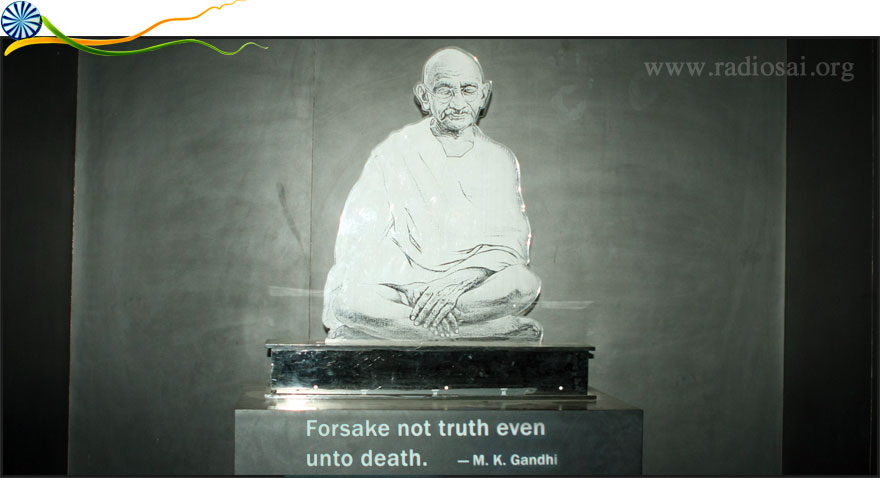|
|
| 'Like' us on Facebook | Follow us: |
Posted on: Aug 15, 2013
THE TRUE FLAG OF VICTORY
Bhagawan Speaks on Bharat
Nearly two and half decades ago while speaking to the students of His university on this day of India's independence Baba clearly set forth before the young minds the ideals and idols they should pursue. He also elucidated what independence means in its truest sense. Here are a few excerpts from that revealing discourse delivered on August 15, 1985.
 |
One must learn lessons from one's mistake, repent and resolve not to commit it again. The history of India holds forth before us the folly of repeating the wrongs already done.
The French, the Portuguese, the Moghuls and the Afghans have all warned Indians against this nature. French Governor Dupleix has recorded that he was able to establish French rule in the then Karnataka region with the help of the Nizam. Mir Jaffer helped Lord Clive to conquer Bengal. Raghunatha Rao Peshwa helped the foreigner to conquer Maharashtra.
Foreign rule was established in India, with the help of Indians themselves. Inhabitants of an island, eleven thousand miles away, were able to conquer India, sixteen times its size having eight times its population, and rule over it for one hundred and ninety years, because of one basic defect - disunity caused by mutual suspicion, selfishness and jealousy. Union is strength; disunion brings disaster.
When Gandhi was twenty-four years old, he proceeded to South Africa at the invitation of an Indian business house to conduct a court case. There he witnessed the humiliation being heaped upon Indian settlers by the Whites. Differences can exist between man and man in health, education, wealth and temperament. But fundamentally all men are equal and should be treated as such. But racial animosity was the accepted policy of the White rulers in South Africa.
The Advent of Sathyagraha by Gandhi
Gandhi stayed on among the oppressed Indians and native blacks and devised the strategy of Sathyagraha (passive resistance or civil disobedience) to end the exploitation. When the movement showed signs of quick success, General Smuts invited Gandhi for discussion.
Gandhi explained to him that he had to resort to non-violent Sathyagraha since the inhuman policy of insulting and injuring humans having black skins had to be resisted and exterminated. General Smuts retorted by pointing out to Gandhi how millions of Indians - human beings like the rest - were kept out of villages and condemned as untouchables. The General's word acted as a bullet shot right at the heart of Gandhi.
Gandhi felt that he had no right to correct another while he was himself infected with the same evil. He decided to return to India and practise the strategy of Sathyagraha for the removal of untouchability and other social evils and to free his Motherland from exploitation by foreigners.
Sathyagraha was the path of Truth and Love, of the means being as pure as the ends. Verily, he who accepts criticism gladly and thanks the critic for his remarks is the one really human. Since Gandhi was willing to learn and had the humility to acknowledge criticism, he could mould the people of his land and be hailed as the Father of the Nation.
 |
He looked upon the country as one. He planted the seed of unity of all faiths and all communities, which under his guidance grew quickly into a big tree. He built a great movement on the basis of Atma balam (soul-force) that strengthened unity and self-confidence. Selfishness that had possessed the nation as an evil genius and mined its progress in material, moral, political and spiritual fields, was suppressed while the movement was on. The people suffered much but sufferings are the prelude to success. There is no rose without thorns. Without giving, no one can gain. How can anything great be achieved without overcoming internal and external obstacles?
The Meaning of Swatantra and Swarajya
The independence we celebrate today was finally achieved and proclaimed at midnight on August 14, 1947. What exactly does the word 'independence' mean?
It means we are not dependent on anyone, any longer. We are dependent on ourselves alone. The Indian word for independence is Swa-tantra. It means 'our Tantra'. The word Tantra means 'the Atma'... So Swatantra means independence from everything except the Atma.
One should always follow only one's heart; that is our only Guru and God. There should be no dependence on the others. This is the stage of Swarajya, becoming the sole monarch of oneself. The word Swaraj, commonly used for an independent state, connotes only absence of worldly dependence. Independence can be enjoyed by man only if he gets rid of bondage to the senses which drag him into tantalising ventures. The attainment of Yoga, involving sense-control, expansion of love, and cleansing the consciousness, is the true goal. Only when this happens can God's glory be reflected in the heart of every individual.
The True Flag of Victory
Love for one's motherland is good. But it should not lead to hatred towards the motherland of others. Your prayer has to be, "May everyone everywhere be happy and peaceful." For, only when the world has peace and prosperity, can India be peaceful and happy... Your peace and happiness are linked with the world's peace and happiness. Any act of hatred or violence committed by you will pollute the atmosphere of the world. When you adore any living being, the adoration reaches God, for He is in every being. Similarly insult to any living being too reaches God. So, expand love towards all, everywhere.
 |
The flag is the symbol of victory, of the joy of Independence. Each nation has a flag for itself. Pay attention to another flag to symbolise another laudable victory. And this is over one's lower instincts, impulses, passions, emotions and desires. This is the flag which has to be unfurled in every human heart. When you achieve this victory, you will become the true inheritors of Bharatiya (Indian) culture.
- Divine Discourse on Independence Day, August 15, 1985
at the Sri Sathya Sai Institute of Higher Learning, Prasanthi Nilayam.
What are your impressions about this article? Please share your feedback by writing to h2h@radiosai.org. Do not forget to mention your name and country.







